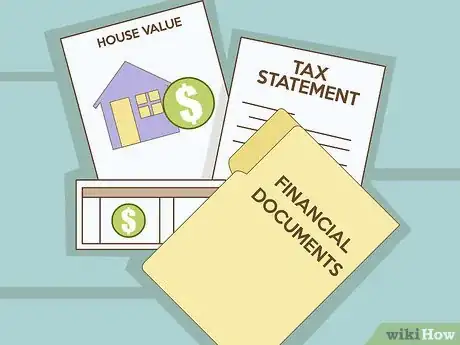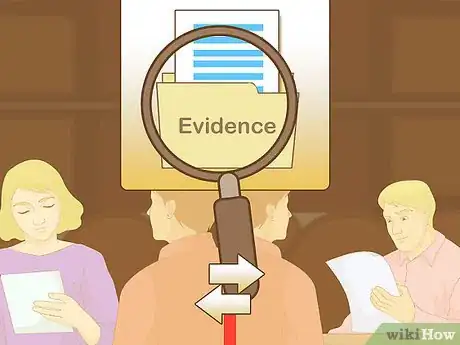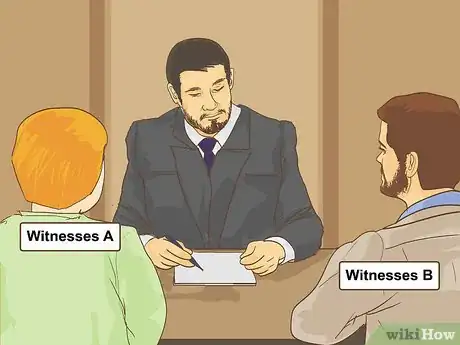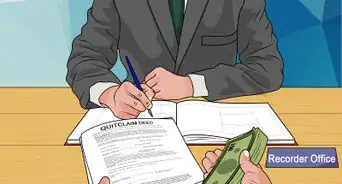This article was co-authored by Scott Levin. Scott Levin is a Divorce Mediator & Family Lawyer, as well as the Founder of San Diego Divorce Mediation. With nearly 20 years of experience, he specializes in peacefully mediating divorces so couples split amicably. He holds a law degree from the University of Chicago School of Law and a Bachelor’s degree in Metropolitan Studies from New York University. Additionally, Scott is a licensed attorney in California, a Certified Divorce Financial Analyst, and a member of The Academy of Professional Family Mediators.
There are 10 references cited in this article, which can be found at the bottom of the page.
wikiHow marks an article as reader-approved once it receives enough positive feedback. In this case, several readers have written to tell us that this article was helpful to them, earning it our reader-approved status.
This article has been viewed 93,753 times.
When you divorce or separate, you need to divide your property and debts with your ex-spouse. Accordingly, you should draft a property settlement agreement. In the agreement, you identify joint property and debts. You then divide them between the two of you. Before you can write the property settlement agreement, you must first decide what you want. A property settlement agreement may be part of a larger separation or divorce settlement agreement.
Steps
Reaching an Agreement
-
1Decide what you want. Before talking with your spouse, you need to be clear in your own mind about what property you want and what debts you are willing to take on alone.
- You might want to meet with a lawyer for a consultation. In the absence of an agreement, your state law will determine who gets what. Accordingly, you should understand the “default” rules before going into negotiations.
- For example, if you are entitled to half of all marital assets, there is no reason to get less than half in the marital settlement agreement.
-
2Identify your marital assets. You will need to divide assets you own jointly with your spouse. You won’t divide separate property, which you own individually. Each state’s laws will determine what you own jointly and what you own separately.
- In a “common law” state, any asset acquired during marriage belongs to the person who bought it. However, if both names are on the deed or title, then that piece of property belongs to each.
- In a “community property” state, things are different. All earnings and property bought with earnings belong equally to both spouses as community property. Community property starts with marriage and ends on the date of your separation. Community property states include Arizona, California, Idaho, Louisiana, Nevada, New Mexico, Texas, Washington, and Wisconsin.[1]
- In community property states, a spouse’s separate property is limited to what they bought before marriage, what they bought after separation, or what they have individually inherited or were given as a gift.
Advertisement -
3Calculate marital debts. Just as state law determines which assets are marital, your state law will determine which debts are jointly owed by both spouses. For example, consider the following:
- In a common law state, both spouses owe a debt only if it benefited the marriage, such as to buy food, or if both spouses jointly signed for the debt.[2] All other debts are separate.
- In a community property state, most debts acquired during marriage are shared equally by the spouses. There are some wrinkles which you should discuss with a lawyer.[3]
- Furthermore, in a community property state, the debt is yours alone if you incurred it before marriage or after separation.
-
4Talk with your spouse. Ideally, you will reach an agreement on how to divide assets and debts. Find a quiet place to talk away from the children. Before the meeting, each of you should write down a list of marital assets and debts. Compare your lists and talk about who should get what.
- You might not reach an agreement on everything in the first meeting. That’s okay. Continue to meet and work down through your assets and debts, dividing them between you.
- Continue to meet so long as you feel you are making good progress.
-
5Attend mediation if necessary. You might not be able to reach an agreement. If not, consider mediation. In mediation, you and your spouse will meet with a neutral person, the mediator. They will listen to your disagreement and help you both agree to a solution.
- Many courthouses have mediation programs. You should stop in and check.
- You might also find mediators in your phone book or by searching online. Your local or state bar association might also keep a list.
- Generally, you will divide the costs of mediation evenly. Mediators typically charge about $100-200 an hour, though the cost will depend on location.[4]
Starting Your Property Settlement Agreement
-
1Find a sample for your state. Some courts and legal aid clinics have sample property settlement agreements, which may be posted online. Look and print off a copy if you find one. You can use the sample as a model when drafting your own.
- Avoid copying word for word. Instead, analyze whether your situation is slightly different and adjust the form accordingly.
-
2Format your document. You’ll want to type the property settlement agreement. Open a blank word processing document and set the font to something easy to read, such as Times New Roman 12 or 14 point.
- Give your page one-inch margins on all sides.
- You can title the document “Property Settlement Agreement.” Put the words in all caps, bolded, and centered.[5]
-
3Provide important details about the marriage. At the beginning of the document, you should introduce yourself. State the date you were married or entered a domestic partnership and the date of separation.
- For example, you can write, “We are Michael Smith, (‘Husband’) and Julie Smith, (‘Wife’). We were married on May 31, 2000 and separated on February 1, 2017. Because of irreconcilable differences, our marriage has broken down.”[6]
- If you’re a same-sex couple, you can use your first names instead of “Husband” and “Wife.” Also use first names if you are ending a domestic partnership.
-
4State that you have made a full disclosure of assets. If either spouse hides assets, then the judge might not approve your property settlement agreement. Accordingly, you must disclose everything and confirm that you have at the beginning of the settlement agreement.
- For example, you can write, “Each of us states that we have made full disclosure, and that we have included everything we are aware of when listing assets that we own. Each of us states that we believe the other person has been forthcoming when writing this property settlement agreement. We agree to be bound by this agreement and agree to exchange any papers needed to complete this agreement.”[7]
Dividing Assets and Debts
-
1List which property person A transfers to person B. Preface the list with something like “Jonah transfers to Allen as Allen’s sole and separate property” and then list the property underneath. For example, you might transfer any of the following:[8]
- tangible assets, such as furniture in your home, a vehicle, jewelry, art, etc.
- your pets
- cash accounts, savings bonds, and other financial instruments
- all or part of the cash value of a life insurance policy
- sentimental gifts of little material value
-
2Identify the property spouse B transfers to spouse A. Do the same as you did just above. For example, you can type out “Allen transfers to Jonah as Jonah’s sole and separate property” and then list the items.
- If you didn’t have any joint property, then you can write, “We have no community property” or “We have no marital property.”
-
3State which debts spouse A will pay. For example, you can write, “Husband will pay the following debts and will not hold Wife responsible for them at any time.”[9] Then list the debts, such as the following:
- credit card debts
- student loans
- debts owed to department stores or other vendors
- personal loans
-
4List the debts the other spouse will pay. Type something like, “Wife will pay the following debts and will not hold Husband responsible for them at any time” before listing the debts she has agreed to be responsible for.[10]
- As a rule of thumb, you should assign the debt to the person who benefited the most from the debt. For example, one spouse should assume the loan for their car.
- If you didn’t have any unpaid debts, this section could simply read: “We have no unpaid joint debts” or “We have no unpaid community obligations.”
-
5Acknowledge separate property. You have the option of listing each spouse’s separate property. This can help clear up any confusion that might arise whether property is jointly owned. Be as detailed as possible when describing property.
- For example, don’t simply identify a vehicle as “car.” Instead, write “2015 Ford Focus” and the Vehicle Identification Number (VIN).
- Even if you and your spouse have already divided a property, it's important to spell out the terms in a divorce settlement or agreement.
-
6State who will remain in the home. One of you may stay in the home with your children. You should spell out the conditions of the person staying in the home. State its location and identify who will pay the expenses associated with maintaining the home.
- For example, you could write, “Wife will live in the home, located at 1234 South Street, Any City, until the earliest of the following: the youngest child turns 18, graduates high school, or is emancipated. While living in the house, Wife agrees to pay all expenses, which includes mortgage payments, insurance, utility bills, maintenance, and taxes.”[11]
-
7Identify what will happen to the home in the future. At some point, your last child will become emancipated, and you should identify what will happen to the home at that point. For example, you can agree to sell the home and divide the equity. State how you want to divide the equity, e.g., 50/50.[12]
- You might want to give one spouse the opportunity to purchase the other spouse’s portion of the equity.
-
8Waive spousal maintenance (“alimony”). If each side is waiving maintenance, then you can state so in the property settlement agreement. However, if one spouse agrees to pay maintenance, it might be a better idea to put that information in its own document.
- You can waive maintenance by stating: “Husband and Wife each waive any claim to spousal maintenance now and for all time.”[13]
Finalizing Your Agreement
-
1Include some boilerplate provisions. These provisions are meant to protect you in case a dispute breaks out over the property settlement agreement. Hopefully, everything will go smoothly, but you should protect yourself just the same.
- Add a statement that each spouse has been advised by independent attorneys of your own choosing.[14]
- State that the agreement is the final agreement related to the matters included in the document.
- Agree that the winning party in a lawsuit is entitled to reasonable costs and attorney’s fees. This provision can help you avoid frivolous lawsuits.
-
2Show the draft to a lawyer. Before signing, each side should have their own lawyer look it over. Don’t use the same attorney. Instead, each spouse should have independent counsel. Meet to discuss any changes each side’s lawyer has suggested.
-
3Insert signature blocks. There should be a line for each spouse to sign. Depending on your state, you may also need two witnesses, who should have signature lines as well.[15]
-
4Add a notary block, if necessary. You might need to sign your property settlement agreement in front of a notary public. Check with your lawyer. If so, you should find an appropriate notary block online and insert it after the signature blocks.
- Remember not to sign your agreement until you appear in front of the notary. You can find notaries at your courthouse, town office, or at most large banks. Bring acceptable forms of personal identification, such as a valid passport or state-issued ID.
-
5Submit your settlement agreement to the court. A judge will need to approve the division of property and debts. You should submit the signed marital settlement agreement to the court for the judge’s signature. You may have to attend a hearing where the judge will ask some basic questions to determine that each side negotiated the agreement fairly.[16]
- You may have to attach your settlement agreement to a petition or other document. Ask your lawyer what you need to file.
- Each spouse should keep a copy of the property settlement agreement for their records.
References
- ↑ http://family.findlaw.com/marriage/what-s-mine-is-mine-what-s-yours-is-mine-who-owns-what-in.html
- ↑ https://www.nolo.com/legal-encyclopedia/debt-marriage-owe-spouse-debts-29572-2.html
- ↑ http://family.findlaw.com/marriage/what-s-mine-is-mine-what-s-yours-is-mine-who-owns-what-in.html
- ↑ http://www.nolo.com/legal-encyclopedia/divorce-mediation-faq-29035-6.html
- ↑ http://www.courts.ca.gov/documents/propagreeinst.pdf
- ↑ http://www.courts.ca.gov/documents/propagreeinst.pdf
- ↑ http://www.courts.ca.gov/documents/propagree.pdf
- ↑ http://www.courts.ca.gov/documents/propagreeinst.pdf
- ↑ http://www.courts.ca.gov/documents/propagreeinst.pdf
- ↑ http://www.courts.ca.gov/documents/propagreeinst.pdf
- ↑ http://family.findlaw.com/divorce/sample-form-property-settlement-agreement.html
- ↑ http://family.findlaw.com/divorce/sample-form-property-settlement-agreement.html
- ↑ http://www.courts.ca.gov/documents/propagreeinst.pdf
- ↑ http://family.findlaw.com/divorce/sample-form-property-settlement-agreement.html
- ↑ http://family.findlaw.com/divorce/sample-form-property-settlement-agreement.html
- ↑ http://family.findlaw.com/divorce/settlement-agreements-and-court-approval.html
About This Article
If you’re getting divorced or separated, you’ll want to write a property settlement agreement to determine how your property will be divided. Sit down with your spouse and agree on how you’ll divide your property and debts, like furniture, vehicles, pets, cash accounts, savings bonds, and loans. You’ll also need to agree on whether one of you will stay in the house or if you’ll sell it. If you can’t reach an agreement after a few meetings, consider going to mediation, where a professional can help you settle things. Once you’ve reached an agreement, get a sample agreement from your local court or draft your own. You’ll need to include both your names, your marriage date, and separation date. Then, detail who will receive each of your assets and debts. You’ll both need to sign the agreement, then file it with your court. For more tips, including how to format your agreement, read on.



















































































